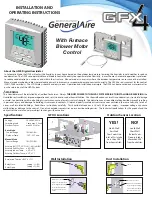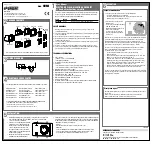
Page 4
compromise between RH levels that are desirable for
comfort reasons and humidity levels, which will avoid
condensation on your windows.
The humidistat can be used to accurately determine the
RH in your home during the winter. With the furnace
blower operating at the heating speed, turn the dial to the
lowest setting, then reverse the dial direction slowly until
you hear the solenoid valve click on. At this point, read the
RH on the dial. This will be very close to the actual RH in
your home. To check the humidifier operation, set the
knob to
TEST
. Make sure that the water saddle valve is
open and that there is electricity to the unit. Generally, the
furnace blower motor must be operating for the humidifier
to function. After the humidifier has operated for one
minute and water is entering the unit and coming out at
the drain, reduce the humidistat setting to the
recommended inside RH, depending on the outside
temperature. Do not leave in the control in the test mode.
The humidifier will not operate properly in the test mode.
Anticipate a drop in the outside temperature and lower the
setting several hours before the drop in outdoor
temperature occurs.
Water Characteristics
Your humidifier will operate effectively using either hard
or mechanically softened water.
Any type of water (hard, soft, hot, or cold) is acceptable
for use with the HCWB2 or HCWP2 humidifiers. Hot
supply water (140
°
F maximum) is recommended for all
heat pump applications. The use of hot supply water will
also increase the unit’s capacity.
Risk of Scalding. Water temperature
over 125°F can cause severe burns and
can scald instantly. Shut off the hot wa-
ter supply before disconnecting or tap-
ping into any hot water supply line.
WARNING
!
Annual Maintenance
For best performance, you should replace the humidifier
pad at least annually. Call your dealer for preventative
maintenance and replacement components.
Annual Shutdown
For the summer humidifier shutdown, turn the universal
humidistat or manual humidistat to the
OFF
setting
(HCWB2−12, 17 and 17A and HCWP2−18 and −18A) and
close the damper (HCWB2−12, −12A, −17 and 17A).
Maintenance
NOTE − Annual inspection and maintenance is important
for efficient and safe operation of your humidifier. Call
your dealer for humidifier service and maintenance
inspection. Parts are available through your Lennox
dealer.
Your humidifier is equipped with an in−line water strainer
and orifice as shown. These parts should be inspected
and cleaned periodically to assure continued proper unit
performance. Inspect more often if white dust" is evident.
FIGURE 3
SOLENOID VALVE COMPONENTS
OUTLET
COMPRESSION
NUT
INLINE
STRAINER
SOLENOID
VALVE
INLET
ORIFICE
INLET
COMPRESSION
NUT
1 − Disconnect electrical power to the
furnace and shut
off water supply.
2 − Disconnect the water line at the inlet compression
nut.
3 − Use a small nail or wire to remove the in−line strainer
from inside the inlet side of the valve.
4 − Flush the in−line strainer clean or replace with a new
strainer.
5 − Reinstall the in−line strainer and reconnect the inlet
water line. Use the double−wrench technique to
prevent leaking.
6 − Disconnect the water line at the outlet compression
nut.
7 − Check the orifice to make sure the small opening is
unplugged. Do not try to remove the orifice from the
copper tube.
8 − Reinstall the orifice and reconnect the outlet water
line. Use the double−wrench technique to prevent
leaking.
9 − Check to ensure that the copper tube is inside the
plastic sleeve.
10− Turn on water supply and reconnect electrical power
to the furnace.
11− Allow the system to operate for a few minutes. Check
for water leaks and re−tighten fittings, if necessary.
























